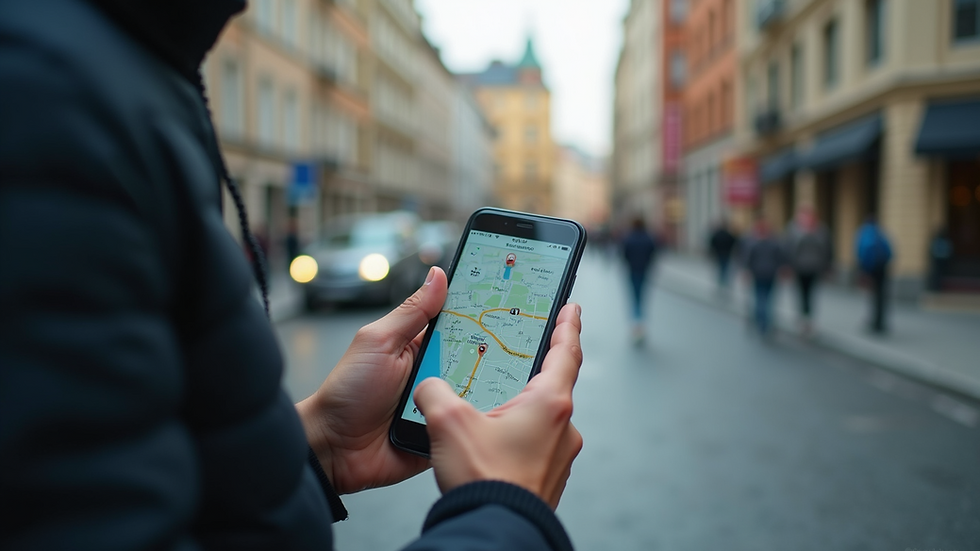Optimizing Geolocation Strategies for Increased Client Base
- alnazahacompany202
- Jul 27
- 5 min read
In today's digital world, businesses are constantly looking for ways to expand their reach and attract new clients. One effective method to achieve this is through geolocation strategies. By understanding where your potential customers are located, you can tailor your marketing efforts to meet their specific needs. This blog post will explore how to optimize geolocation strategies to increase your client base, providing practical tips and examples along the way.
Geolocation is the process of identifying the geographic location of a device or user. This information can be incredibly valuable for businesses, allowing them to target their marketing efforts more effectively. By leveraging geolocation data, you can create personalized experiences for your customers, leading to higher engagement and conversion rates.
Understanding Geolocation
Before diving into strategies, it is essential to understand what geolocation entails. Geolocation uses various technologies, such as GPS, Wi-Fi, and IP addresses, to determine a user's location. This data can be used to provide location-based services, such as targeted advertisements, local promotions, and personalized content.
For example, a coffee shop can use geolocation to send special offers to customers who are nearby. This not only encourages foot traffic but also creates a sense of urgency for potential customers to visit the shop.
The Importance of Geolocation in Marketing
Geolocation plays a crucial role in modern marketing strategies. Here are a few reasons why it is essential:
Targeted Advertising: By knowing where your customers are, you can create ads that resonate with them. For instance, a local restaurant can promote its lunch specials to people in the area during lunchtime.
Enhanced Customer Experience: Personalized experiences lead to happier customers. When users receive relevant offers based on their location, they are more likely to engage with your brand.
Increased Conversion Rates: Targeted marketing efforts often result in higher conversion rates. When customers see offers that are relevant to them, they are more likely to make a purchase.
Optimizing Your Geolocation Strategy
Now that we understand the importance of geolocation, let's explore how to optimize your strategy effectively.
1. Collect Accurate Location Data
The first step in optimizing your geolocation strategy is to collect accurate location data. This can be done through various methods, including:
Mobile Apps: If you have a mobile app, encourage users to enable location services. This will allow you to gather precise data about their whereabouts.
Website Tracking: Use tools like Google Analytics to track the location of your website visitors. This data can help you understand where your audience is coming from.
Surveys and Feedback: Ask your customers for their location information through surveys or feedback forms. This can provide valuable insights into your client base.
2. Segment Your Audience
Once you have collected location data, the next step is to segment your audience. This means dividing your customers into groups based on their geographic location. By doing this, you can tailor your marketing efforts to each segment.
For example, if you have customers in different cities, you can create specific promotions for each location. This approach ensures that your marketing messages are relevant and resonate with your audience.
3. Utilize Location-Based Advertising
Location-based advertising is a powerful tool for reaching potential customers. Here are some effective strategies:
Geofencing: This technology allows you to create virtual boundaries around a specific location. When users enter this area, they can receive targeted ads or notifications. For instance, a retail store can send a discount offer to customers who walk by.
Local SEO: Optimize your website for local search terms. This will help your business appear in search results when users look for services in their area. For example, if you run a bakery in New York, ensure your website includes keywords like "New York bakery" or "best pastries in NYC."
Social Media Targeting: Use social media platforms to target ads based on location. Facebook and Instagram allow you to specify the geographic area where your ads will be shown, ensuring they reach the right audience.
4. Create Location-Specific Content
Creating content that speaks to your audience's location can significantly enhance engagement. Here are some ideas:
Local Events: Write blog posts or social media updates about local events happening in your area. This not only positions your brand as a community player but also attracts local customers.
Customer Stories: Share testimonials or case studies from customers in specific locations. This builds trust and shows potential clients that you have a proven track record in their area.
Localized Offers: Promote special offers that are exclusive to certain locations. This creates a sense of urgency and encourages customers to take action.
5. Monitor and Analyze Results
To ensure your geolocation strategy is effective, it is crucial to monitor and analyze the results. Use analytics tools to track the performance of your campaigns. Look for metrics such as:
Click-Through Rates (CTR): This measures how many people clicked on your ads. A high CTR indicates that your ads are resonating with your audience.
Conversion Rates: Track how many users completed a desired action, such as making a purchase or signing up for a newsletter. This will help you understand the effectiveness of your geolocation efforts.
Customer Feedback: Regularly gather feedback from your customers to understand their experiences. This can provide valuable insights into what is working and what needs improvement.
Real-World Examples of Successful Geolocation Strategies
To illustrate the effectiveness of geolocation strategies, let's look at a few real-world examples.
Starbucks
Starbucks has successfully implemented geolocation strategies to enhance customer engagement. The Starbucks app allows users to find nearby locations and receive personalized offers based on their location. For instance, if a customer is near a Starbucks store, they may receive a notification about a special promotion on their favorite drink.
Target
Target uses geolocation to enhance the shopping experience for its customers. The Target app provides users with a store map, helping them find products quickly. Additionally, the app sends personalized offers based on the user's location within the store, making the shopping experience more efficient and enjoyable.
Uber
Uber leverages geolocation to connect drivers with riders effectively. The app uses GPS to match riders with nearby drivers, ensuring quick pickups. This geolocation strategy has been a key factor in Uber's success, as it provides a seamless experience for users.
The Future of Geolocation Strategies
As technology continues to evolve, so will geolocation strategies. Here are a few trends to watch for in the future:
Increased Use of AI: Artificial intelligence will play a significant role in analyzing geolocation data. Businesses will be able to predict customer behavior and preferences more accurately.
Enhanced Privacy Measures: As concerns about privacy grow, businesses will need to implement transparent practices for collecting and using location data. This will build trust with customers and ensure compliance with regulations.
Integration with Augmented Reality (AR): Geolocation will increasingly be integrated with AR technologies. This will allow businesses to create immersive experiences for customers, such as virtual tours or interactive promotions.
Wrapping Up Your Geolocation Journey
Optimizing your geolocation strategies can significantly increase your client base. By collecting accurate location data, segmenting your audience, utilizing location-based advertising, creating localized content, and monitoring results, you can create a powerful marketing approach that resonates with your customers.
As you implement these strategies, remember to stay adaptable and open to new technologies. The world of geolocation is constantly changing, and staying ahead of the curve will ensure your business thrives in the competitive landscape.




Comments